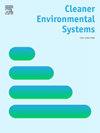Life cycle assessment of an Australian higher education institution – The case study of the Queensland university of technology
IF 4.9
Q2 ENGINEERING, ENVIRONMENTAL
引用次数: 0
Abstract
The environmental impact of the operation of an Australian University, i.e. the Queensland University of Technology (QUT), in 2022 has been assessed by applying the recently published life cycle assessment guidelines for Higher Education Institutions. Overall, 16 environmental impact categories were considered based on ISO 14072. QUT's energy supply was identified as the most substantial impact overall, accounting for over 48 % in each of eight impact categories. Airconditioning (with the use of the refrigerant R134a) has the highest impact on the ozone depletion category. Transport exhibits the second most significant impact in eight of the 16 impact categories, mostly due to international air travel by international students and staff. Infrastructure has the most significant impact in six categories but is probably underestimated due to lack of data. In addition, suggestions how to reduce QUT's environmental impact are discussed. Subsequently, recommendations to develop the LCA guidelines for HEIs further are presented.

澳大利亚高等教育机构的生命周期评估——以昆士兰科技大学为例
根据最近发布的《高等教育机构生命周期评估指南》,对澳大利亚昆士兰科技大学(QUT)在2022年的运营对环境的影响进行了评估。总体而言,基于ISO 14072考虑了16个环境影响类别。昆士兰科技大学的能源供应被认为是整体影响最大的,在8个影响类别中每个类别都占48%以上。空调(使用制冷剂R134a)对臭氧消耗类别的影响最大。交通运输在16个影响类别中的8个类别中表现出第二大影响,主要是由于国际学生和工作人员的国际航空旅行。基础设施在六个类别中具有最重要的影响,但由于缺乏数据,可能被低估了。此外,本文还对如何减少科技大学的环境影响提出了建议。随后,本文提出了进一步为高等院校制定LCA指南的建议。
本文章由计算机程序翻译,如有差异,请以英文原文为准。
求助全文
约1分钟内获得全文
求助全文
来源期刊

Cleaner Environmental Systems
Environmental Science-Environmental Science (miscellaneous)
CiteScore
7.80
自引率
0.00%
发文量
32
审稿时长
52 days
 求助内容:
求助内容: 应助结果提醒方式:
应助结果提醒方式:


